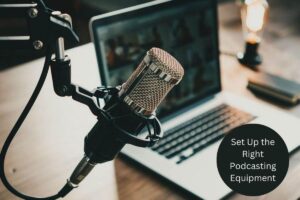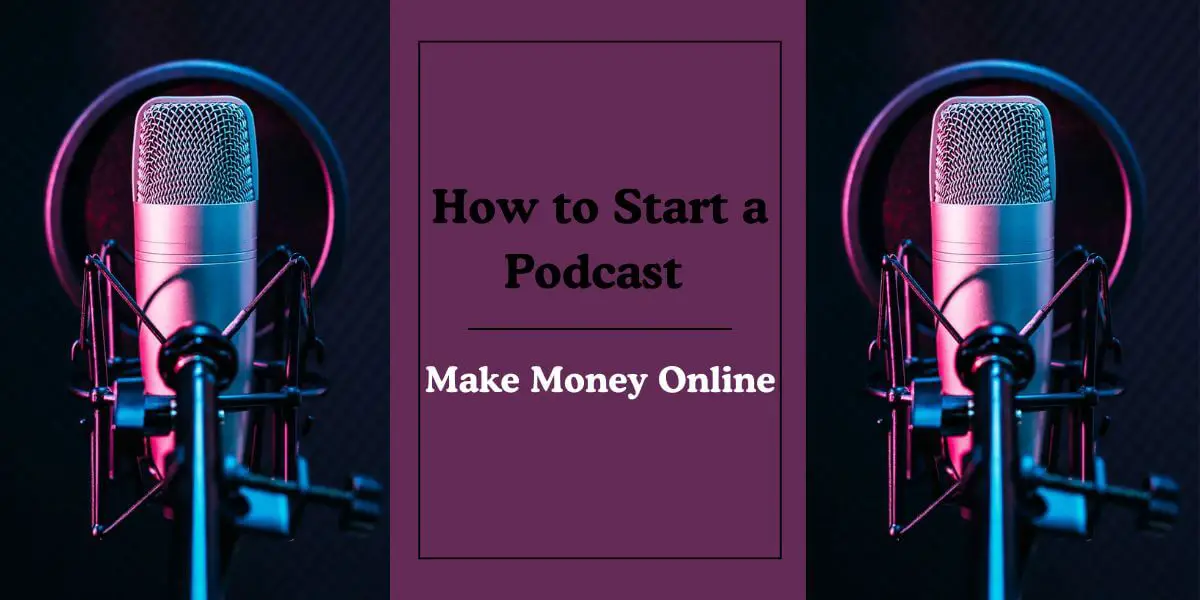Podcasting has grown rapidly over the last few years, with millions of listeners tuning in daily to consume everything from news and entertainment to self-improvement tips. With low startup costs and the potential for multiple revenue streams, podcasting is an exciting way to build a brand, engage with an audience, and earn money online. Whether you’re passionate about storytelling, interviewing experts, or sharing your knowledge, starting a podcast could open new doors to passive income and creative freedom.
In this article, I’ll walk you through the steps to inform you how to start a podcast, covering everything from selecting the right niche to monetizing your content. Even if you’re a complete beginner, this guide will help you build, grow, and make money from your podcast over time.
Step 1: Pick a Podcast Niche That Can Be Monetized
Finding the right niche is crucial when starting a podcast because it determines your audience, content direction, and potential income streams. A profitable niche strikes the right balance between what you love and what listeners are eager to hear.
Why Your Niche Matters
Your podcast’s topic will define who listens to your episodes and how much they engage with your content. When you focus on a well-defined niche, you’re more likely to attract loyal listeners who share your passion. These engaged audiences are also more attractive to sponsors, affiliates, and other monetization partners.
For example, podcasts about personal finance, wellness, technology, and true crime often have dedicated followers and profitable revenue streams. People search for podcasts that cater to their specific interests, which means finding a niche helps you stand out among thousands of shows.
Researching and Testing Your Niche
To select a podcast niche, start by brainstorming ideas that align with your interests and expertise. But passion alone isn’t enough; there needs to be a market demand.
- Validate demand: Look at similar podcasts in your niche. Are they gaining listeners? Are they monetized through ads, sponsorships, or merchandise? Platforms like Spotify and Apple Podcasts offer great insights into trending shows.
- Join online communities: Explore forums like Reddit, Facebook groups, or Quora to see what people are discussing. If a topic is already generating interest, it’s likely to succeed as a podcast.
It’s also helpful to narrow your niche within a broader category. For example, instead of starting a general wellness podcast, focus on “mindfulness for busy moms” or “mental health for entrepreneurs.” A well-defined niche helps you build a loyal, engaged audience, setting you up for long-term growth and profitability.
Research is very important if you are to start a business. You need to focus on the most important topics that you love to share with your audience. I know everyone’s goals and capabilities are different. So, contact us to get personalized advice for your podcast business.
Step 2: Plan Your Podcast Format and Structure
Once you’ve selected a niche, the next step is to design your podcast’s format and structure. Having a clear plan will help you stay organized, consistent, and prepared for each episode.
Types of Podcast Formats
There are several popular formats to choose from, and each has its pros and cons:

- Interview-based: If you love talking to experts or influencers, an interview-based podcast could be a good fit. This format also offers opportunities for cross-promotion, as guests may share the episode with their audiences.
- Solo show: A solo podcast allows you to share your thoughts, insights, or personal stories without relying on guests. This is ideal if you prefer full control over your content.
- Panel discussions: This format involves multiple hosts discussing a topic together. It’s conversational and works well if you have co-hosts with differing perspectives.
- Narrative storytelling: Perfect for fiction or documentary-style content, narrative podcasts weave stories through episodes, keeping listeners hooked.
A podcast uploaded to YouTube is still considered a podcast, though it’s often referred to as a video podcast. Traditionally, podcasts were audio-only and distributed through platforms like Spotify or Apple Podcasts. However, with the rise of video content, many podcasters now record and upload their shows to YouTube.
Length and Frequency of Episodes
The length and frequency of your podcast will depend on your topic and target audience. Some listeners prefer quick, 15-minute episodes that they can squeeze into their daily routine, while others enjoy deep dives that span over an hour.
As a general rule:
- Short-form content: 15–30 minutes per episode. This works well for tips, advice, or brief interviews.
- Long-form content: 45 minutes to an hour or more. Ideal for detailed conversations, storytelling, or multi-topic discussions.
Equally important is maintaining consistency. Decide how often you’ll publish—whether it’s weekly, bi-weekly, or monthly—and stick to the schedule. Consistency helps build listener trust and keeps your audience coming back for more.
Step 3: Set Up the Right Podcasting Equipment
Starting a podcast doesn’t require a huge investment, but good-quality equipment is essential to create a professional-sounding show. Audio quality is one of the most critical factors in building and retaining an audience, so it’s worth investing in a few key tools.
Essential Tools and Software
At a minimum, you’ll need:
- Microphone: A USB microphone, such as the Blue Yeti or Audio-Technica ATR2100x, is affordable and delivers clear sound.
- Headphones: A pair of over-ear headphones helps you monitor audio quality during recording and editing.
- Recording software: You can use free tools like Audacity (for beginners) or Adobe Audition (for advanced users) to edit your audio.

You’ll also need a hosting platform to upload your episodes and distribute them to streaming services like Spotify and Apple Podcasts. Popular podcast hosting services include Buzzsprout, Anchor, and Podbean, all of which offer easy setup and analytics tools to track downloads and listeners.
To start a video podcast, you’ll need a mix of equipment and software. Use a camera (webcam, DSLR, or smartphone) and a quality microphone (like Blue Yeti or Shure SM7B) for clear audio. Lighting tools, such as ring lights or softboxes, ensure good visuals, while headphones help monitor sound.
For recording, tools like OBS Studio or Riverside.fm work well, and for editing, you can use Adobe Premiere Pro or DaVinci Resolve. Create thumbnails and graphics using Canva or Photoshop, and store files with external SSDs or cloud storage. If interviewing guests remotely, Zoom or SquadCast are excellent options, and platforms like YouTube Studio help manage uploads and optimize reach.
You may be interested in learning how to make money on YouTube.
Creating a Quiet Recording Space
A quiet environment is just as important as the right equipment. Background noise and echo can ruin the listener experience, making your podcast seem unprofessional. You don’t need a fancy recording studio—just find a quiet room and use rugs, blankets, or foam panels to reduce sound reflections.
Test your audio setup by recording a short demo episode. Make adjustments as needed until your audio is clear and polished. It’s better to solve technical issues early so you don’t have to deal with frustrating fixes later.
Step 4: Record and Edit Your First Few Episodes
Once you’ve nailed down your niche and set up your equipment, it’s time to dive into the actual recording. Your first few episodes are crucial because they will help you define your style, test your equipment, and give you content to launch with.
Recording Techniques for Beginners
Even if you’re new to podcasting, practice can help you sound natural and engaging. Here are some tips to start strong:
- Practice before hitting record: Do a few dry runs to get comfortable speaking into the microphone.
- Be conversational: Write a script or outline to guide you, but don’t read word-for-word—imagine you’re talking to a friend.
- Use vocal variation: Vary your pitch and tone to keep listeners engaged. A monotone delivery can make even interesting topics feel dull.
When recording, keep in mind that it’s okay to make mistakes. You can always edit out errors or retake them later.

Editing for High-Quality Audio
Editing your episodes is where the magic happens. Even if you record perfectly, a little post-production goes a long way in making your podcast sound professional. Here’s what to focus on:
- Remove background noise: Tools like Audacity and Adobe Audition have features that clean up ambient noise.
- Trim silences and mistakes: Edit out long pauses, stumbles, or repeated phrases to maintain a smooth flow.
- Add intro and outro music: A consistent intro gives your podcast a polished feel, while an outro invites listeners to subscribe or engage further.
Editing may feel overwhelming at first, but it gets easier with practice. The goal is to balance clarity with authenticity—your podcast doesn’t need to sound perfect, but it should be easy to listen to.
Step 5: Launch Your Podcast with a Marketing Plan
The launch phase is where you introduce your podcast to the world. A successful launch involves more than just uploading your first episode—you need a strategy to generate buzz and attract listeners.
Submitting Your Podcast to Platforms
To reach your audience, your podcast needs to be available on popular streaming platforms. Most listeners use services like Spotify, Apple Podcasts, or Google Podcasts, so you’ll want to get listed there as soon as possible.
Here’s how it works:
- Sign up for a podcast hosting service (like Buzzsprout, Anchor, or Podbean).
- Upload your episodes and cover art to the host platform.
- Submit your RSS feed (provided by your host) to major platforms like Spotify and Apple Podcasts.
The approval process usually takes a few days. Once approved, your episodes will be available for listeners to stream and download.
Promoting Your Podcast at Launch
To attract listeners right away, you need to market your podcast effectively. Here are some strategies to build momentum:
- Social media promotion: Share teaser clips or behind-the-scenes content on platforms like Instagram, TikTok, and Twitter.
- Email marketing: If you have an email list, send a launch announcement with direct links to your podcast.
- Collaborate with other podcasters: Appearing as a guest on other podcasts can introduce your show to new audiences.
Encourage your listeners to leave reviews and ratings, especially on Apple Podcasts, where high ratings improve your podcast’s visibility.
Step 6: Strategies for Monetizing Your Podcast
Monetizing a podcast or video podcast takes creativity, consistency, and smart strategies. Here are some of the most effective ways to generate revenue from your show:
1. Sponsorships and Advertising
The most common monetization strategy involves sponsorships or ad placements. Brands pay you to mention their products or services in your episodes. There are two types of ads:
- Pre-roll or mid-roll ads: These run before or during the episode.
- Host-read ads: Personalized messages read by the podcast host, which tend to feel more authentic and drive better results for sponsors.
Start by reaching out to small brands in your niche, or use ad networks like Podcorn or Anchor Sponsorships to find partners.
2. Listener Donations and Memberships
You can ask loyal listeners to support your podcast directly through donations or subscription memberships. Platforms like Patreon allow podcasters to offer exclusive content, early access, or bonus episodes to paying members. You can also use Buy Me a Coffee or PayPal for one-time donations.
3. Affiliate Marketing
Affiliate marketing involves promoting products or services through special referral links. When your audience makes a purchase using your link, you earn a commission. Choose affiliate programs relevant to your niche, such as Amazon Associates or niche-specific brands, and mention these products naturally during episodes.
4. Selling Merchandise

Creating branded merchandise is another way to monetize. T-shirts, mugs, stickers, or notebooks with your podcast’s logo or catchphrases can appeal to fans. Use platforms like Teespring or Merch by Amazon to produce and sell without upfront costs.
5. Offering Courses, Consulting, or Services
If your podcast provides expertise in a particular area, monetize by offering online courses, consulting services, or workshops. For example, if your podcast focuses on marketing, you could sell courses on social media strategy.
6. YouTube Monetization for Video Podcasts
If you publish episodes on YouTube, you can earn through YouTube’s Partner Program with ad revenue, provided you meet their eligibility requirements (1,000 subscribers and 4,000 watch hours). Additionally, Super Chats and memberships offer further ways to earn during live streams.
7. Live Events and Speaking Engagements
As your audience grows, you can host live events, workshops, or webinars and charge attendees. Live events not only bring in revenue but also strengthen community engagement.
Monetizing a podcast takes time, but with these diverse strategies, you can gradually build multiple income streams and make your podcast a profitable venture.








